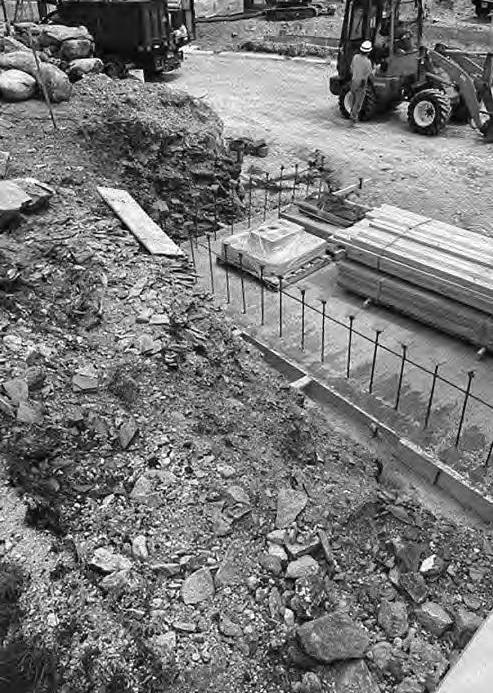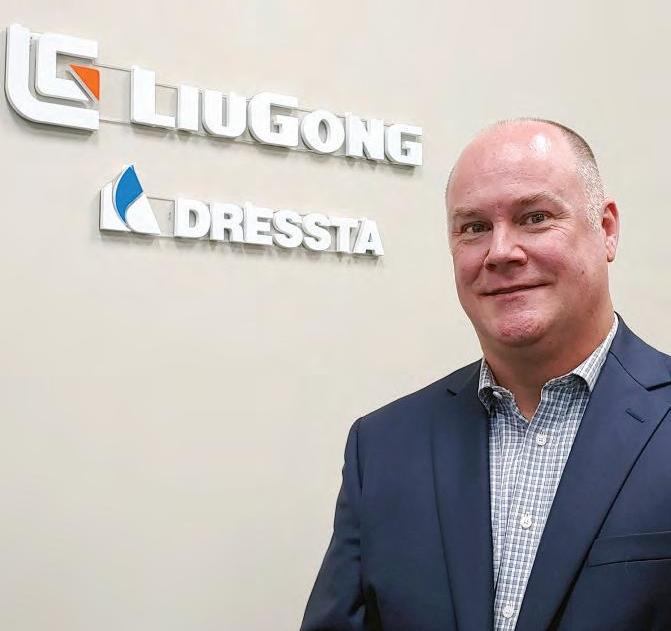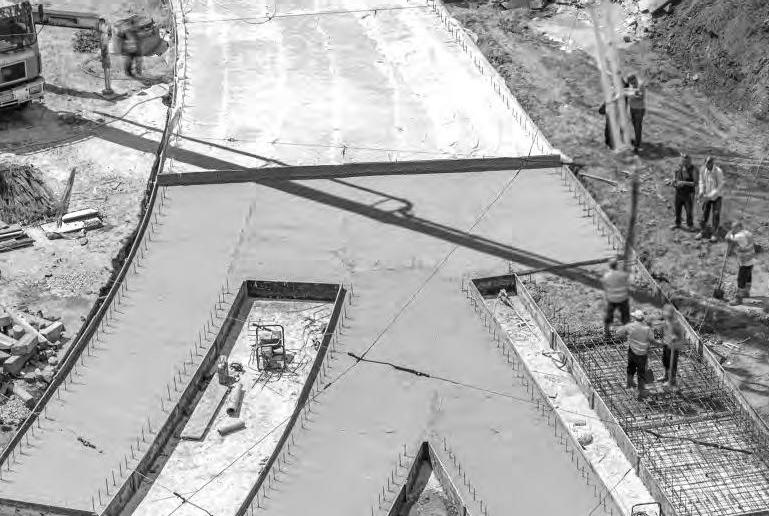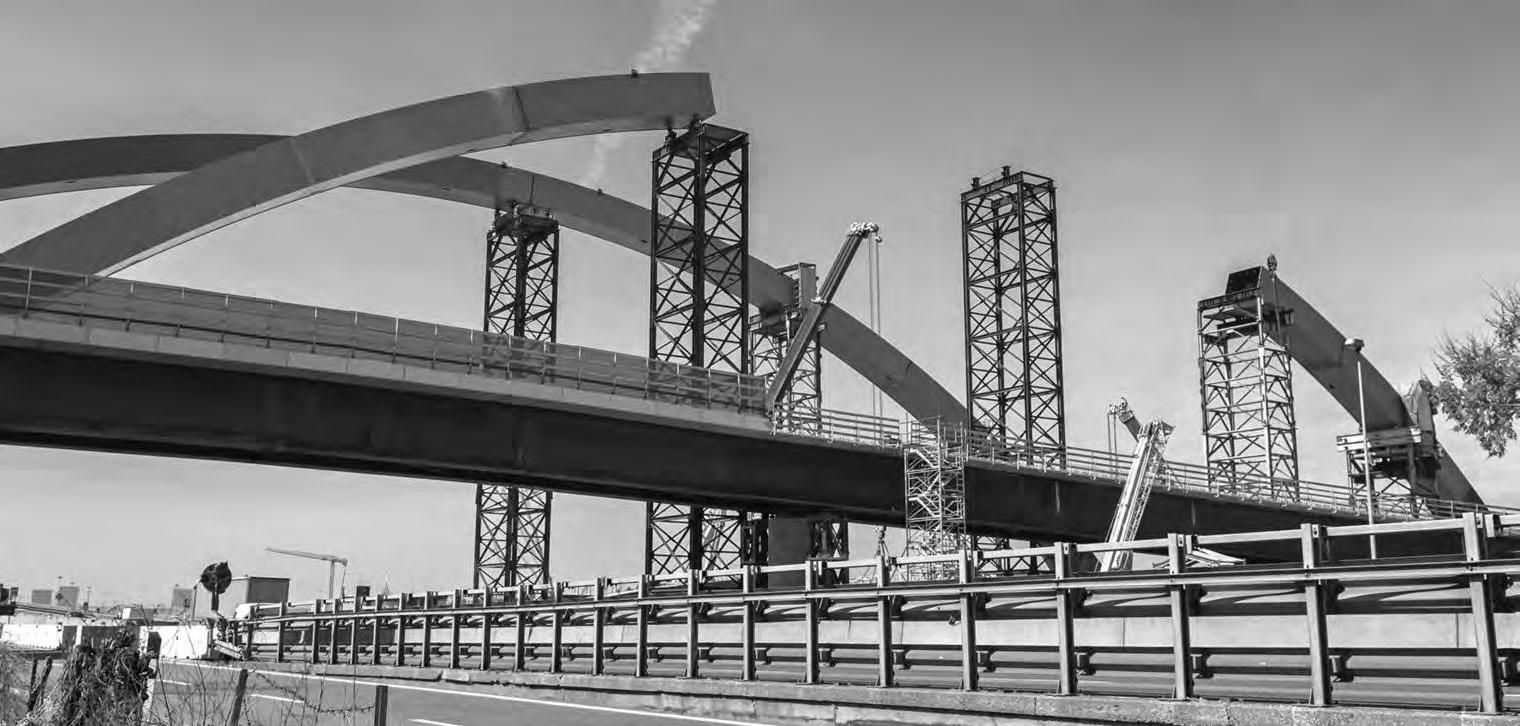
15 minute read
GPR SCANS FOR ANOMALIES FOR HISTORIC CHURCH RENOVATION
In September 2018, architects were hired by the Congregational Church of Hollis to help design and oversee the construction project for a church expansion.
The architects used ground penetrating radar (GPR) during the preliminary planning process for an expansion to a historic church in Hollis, N.H. Using GPR early in the planning process helped to ensure excavation would not disturb any graves. It also minimized the risks of encountering subsurface conditions that could result in delays and increased construction costs.
Architect Looks for Ways to Identify Potential Risks
GPR helps with surveying sensitive archeological sites remotely and non-destructively before excavating. It can pinpoint the places to excavate and indicate which areas should be avoided. Scanning prior to excavating saves time and money and helps to find unknown objects.
Dennis Mires, of Dennis Mires, PA The Architects, used GPR as part of preliminary planning for an expansion of the Congregational Church of Hollis. The church, which was originally founded in 1741, is constrained within a small area between Monument Square, the church cemetery and the town library. The church was proposing an expansion to the front of the church and a lower level patio area.
One part of the expansion is located near a cemetery wall and required approval from several town agencies. The architect wanted to use GPR to identify any potential risks ahead of time. They were especially interested in avoiding burial remains while digging near the historic cemetery, or of coming across any ledge that might be in the construction area.
“We were very interested in demonstrating to the Hollis Cemetery Trustees and the Select Board that we are being proactive in minimizing surprises and making appropriate plans to reduce delays and costs during construction,” explained Mires.
The architect called on local GPR manufacturer Geophysical Survey Systems Inc (GSSI) to conduct a survey in two areas: the right-side yard near the cemetery and the front yard near the church’s existing handicap drop off area. The survey was conducted using GSSI’s UtilityScan GPR system, which is the smallest utility locator on the market. Due to the ease of use, size and cost of this system, it’s used by utility contractors, environmental specialists and archaeologists around the world.
The primary concern was to determine if any burials existed outside of the cemetery boundaries on the right-side yard. Historical burials are typically smaller than 4 to 6 ft. in length and can vary in depths. Therefore, the team was tasked to look for features in oblong shapes about 1 to 4 ft. long.
On the right side yard, GSSI collected data by creating a grid formation of 82 by 82 ft. with lines spaced at 9.8 in. apart. This method was selected to ensure high resolution data.
The data suggested an anomaly and the team recommended further investigation of the top left-hand corner prior to construction. The anomaly’s geometric shape (a 10- by 10ft. block) and shallow depth suggested that it could be an old building foundation. In the 1920s, there were a number of out-buildings associated with the church, which could explain the area found in the data.
The GPR data ruled out potential graves, indicating that there was no danger of hitting any burials. In addition, the area to be excavated had a low potential of bedrock within the top 5 ft. GSSI suggested an additional boring test to confirm the GPR results.
In the front yard, GSSI collected data by creating a grid formation of 55.7 by 32.8 ft. with lines spaced 19.7 in. apart. Previous construction to the church had identified an abandoned underground storage tank (UST) that was removed as part of another project. However, there was still concern about the possibility of additional unknown utilities. Since they weren’t worried about burials on this side, larger spacing was the best method for survey efficiency.
New England soils contain geophysical features that can pose an obstacle for construction sites, such as soil composition and bedrock ledges. In Hollis, N.H., it is not uncommon
Employees from GSSI surveying the front yard of the Church using GSSI’s UtilityScan.

Dennis Mires, PA The Architects photo
The survey was conducted using GSSI’s UtilityScan GPR system, which is the smallest utility locator on the market. Due to the ease of use, size and cost of this system, it’s used by utility contractors, environmental specialists and archaeologists around the world. (Dennis Mires, PA The Architects photo)

Dennis Mires, PA The Architects photo
A view of new community patio area of the lower level of the church.
LiuGong North America Appoints Andrew Ryan as New President
LiuGong North America (LGNA) announced the appointment of Andrew Ryan as president of LiuGong North America, effective Aug. 16, 2021.
Ryan has 25 years of experience in the construction equipment industry. While at Caterpillar, he served in senior roles spanning machine marketing, dealer administration, rental and aftermarket parts. He has a global perspective on the industry having lived and worked in the United States, Chile and Singapore.
“I am excited by the opportunity to work closely with our dealer network and lead the extended LiuGong team to the next phase of growth in North America,” said Ryan.
For more information, visit www.liugongna.com.

Andrew Ryan
Turner Construction Announces Its Inaugural ‘Construction Inclusion Week’
Turner Construction Company announced that the company is a founding member of Construction Inclusion Week and will participate in the inaugural industry-wide event taking place on construction sites and offices Oct. 18 to 22, 2021.
With the theme, “Building the Foundation for Inclusion,” Construction Inclusion Week events will promote the right environment on construction sites and encourage action to advance diversity, equity and inclusion. Topics discussed will highlight leadership commitment and accountability; unconscious bias; supplier diversity; jobsite culture; and community outreach.
Many decades ago, Turner actively began taking steps to increase diversity within the company and industry. Over time, its focus grew to include how the company could address issues of unconscious bias, inclusion and creating the right environment in its workplace.
Each step along the way included taking time to learn more about the issues at hand, having open dialogue and setting in place meaningful programs to address tough, sensitive and very important topics.
The work Turner does and the progress it makes in addressing inclusion, equity, and diversity within the company and on its job sites support broader efforts to address these issues in the industry and in communities. However, the issues being faced will not be solved overnight. The company continues to reach out and work with others to address these issues head on.
In 2020, a group of general contractors: DPR, Clark Construction Group, Gilbane, McCarthy Building Companies, Mortenson and Turner, created a “Time for Change” consortium with a single purpose: identify ways to advance diversity, equity, and inclusion in construction. Through this effort, Construction Inclusion Week was born.
Participation in Construction Inclusion Week gives the opportunity to learn from one another and speak with one voice. Through collaboration, proactive engagement, and deliberate actions, Turner will effect positive change where people celebrate and embrace diversity, foster inclusion and where equity is apparent.
For more information, visit www.constructioninclusionweek.com. Content will be added to the site and participating companies will have access to materials to bring awareness to diversity, equity, and inclusion concepts for job sites, teams, and companies. NORTRAX
www.nortrax.com 1505 Caribou Road • New Canada, ME 04743 207/834-6701 34 Page Road West • Hermon, ME 04401 207/947-6786 106 North Street • Houlton, ME 04730 207/532-6517 396 County Road • Westbrook, ME 04092 207/773-3777 98 Sheep Davis Road • Pembroke, NH 03275 603/225-2769 14 The Crossing Boulevard • Clifton Park, NY 12065 518/371-5111 1486 US Highway 11 • Gouverneur, NY 13642 315/287-0703 300 Clinton Street • Springfield, VT 05156 802/885-6840 375 Engineers Drive • Williston, VT 05495 802/658-2121
RUDD EQUIPMENT COMPANY
www.ruddequipment.com 4344 Poplar Level RD • Louisville, KY 40213 502/456-4050 Pittsburgh, PA 412/741-1731 Clearfield, PA 814/765-8500 Charleston, WV 304/755-7788
SCHMIDT EQUIPMENT INC.
www.schmidtequipment.com 80 Southbridge Rd. • North Oxford, MA 01537 508/987-8786 Billerica, MA 01862 978/667-4345 Plymouth, MA 02363 508/830-9997 No. Swansea, MA 02777 508/379-9810 Springfield, MA 01104 413/543-5595

Some $550 billion in new spending is paid for through various sources, including repurposed COVID-relief funding, fraudulently paid unemployment benefits and other extended or reinstated governmental fees.
BILL from page 44
• the Surface Transportation Investment Act, a $78 billion reauthorization of federal freight and passenger rail programs. • an additional $66 billion in new spending on top of the reauthorization, including $6 billion for Northeast Corridor grants; $36 billion for Federal-State Partnership Intercity Passenger Rail; $16 billion for Amtrak; $5 billion for Consolidated Rail Infrastructure and Safety Improvement program; and $53 billion in other related spending.
Other Relevant Funding: • Ports and Waterways: $17.3 billion • Airports: $25 billion in new spending for airport infrastructure, including $20 billion for runway, taxiway and terminal projects; and $5 billion for air traffic control infrastructure.
The $550 billion in new spending is paid for through a host of sources, according to AGC, including repurposed COVID-relief funding, refunded and fraudulently paid unemployment benefits and other extended or reinstated governmental fees.
Good News for Construction
Stephen Sandherr, CEO of the AGC, said the new infrastructure measure provides much-needed new federal investments in a wide range of infrastructure projects.
ARTBA President & CEO Dave Bauer also heralded the infrastructure bill as a testimony to the strong bipartisan spirit demonstrated in the Senate, which he believes sets the bar high.
“The U.S. economy and transportation system users stand to benefit most from enactment of an infrastructure bill that combines historic investment levels with pragmatic policy reforms,” said Bauer.
He added a caution, though, saying the vote is “a much-needed step but not the finish line.”
Bauer said ARTBA will “continue to work with the House, Senate and the Biden administration to help achieve an outcome that addresses America’s transportation infrastructure needs today and in the future.”
Associated Builders and Contractors echoed much of the construction industry’s positive comments.
Michael Bellaman, ABC president and CEO, said the infrastructure package contains the most significant investment in the nation’s infrastructure in a generation.
It “could yield crucial wins for the American people and construction industry,” said Bellaman, adding that it is promising to see progress made toward transportation modernization.
He believes “common sense” provisions in the bill will cut down on unnecessary delays in federal construction projects and help
CHALLENGES from page 44
people who have chosen not to participate may come back into the market and be able to take those critical jobs.”
Tom Conway, president of United Steelworkers, the largest industrial union in North America, told Bloomberg he’s concerned that the supply crunch means the industry — and contractors — will have to source materials abroad, benefiting other countries with employment gains, instead of the United States.
“Here’s what I think the administration has to be concerned about,” Conway said. “They’re going to press and press and press trying to get an infrastructure bill and all these manufacturers will say, ‘We’re not ready. We need more runway to get ready. So, in the meantime, get it offshore and do the projects and we’ll get started on ours.’”
The housing industry now is worried about the competition from infrastructure projects. The National Association of Home Builders (NAHB) said the United States will need to lift tariffs on lumber and import more key metals to ensure there’s enough aluminum for appliances, copper for wiring and cement for foundations.
Domestic U.S. saw mills haven’t kept up with construction, and the housing industry imports about 30 percent of its lumber from Canada, reported Bloomberg. Lumber prices are up an estimated 400 percent since the start of the 2020 recession.
The infrastructure bill “will place a huge demand for steel and concrete that will impede our ability to build out multifamily and other types of housing,” said Jerry Howard, CEO of NAHB.
The infrastructure bill increases the demand for trained workers, which the United States doesn’t have enough of. The manufacturing industry remains down more than 500,000 positions from February 2020. Immigration could help, but that’s politically challenging, maintained Bloomberg.
“By the time we get to infrastructure hitting the ground, there will be a labor shortage and to some extent the government is going to have to compete with private businesses for people,” said Aneta Markowska, chief U.S. economist of Jefferies.
Delays in passing the infrastructure bill may end up being beneficial, Michael Gapen, chief U.S. economist of Barclays Plc, told Bloomberg. Constraints on supply chains could ease over time, he said.
On the flip side, Johnson of Kapitus pointed out that of all the verticals his firm finances, construction has bounced back from an application standpoint faster than any other.
In fact, Johnson is glad to see the infrastructure bill specifically target domestic manufacturing and procurement. He believes that should drive additional manufacturing growth here and demand for domestic construction business.
All of that, said Johnson, is quite positive for the firm’s client base. “We believe it’s positive for the overall economy as well,” he added. CEG

Larger control valve and electronic controls deliver smooth, precise performance and up to 12% faster cycle times
Shift-long comfort from a spacious cab, automotive-grade seat and ergonomically-designed, fullyadjustable arm rests
Award-winning Wide Angle Visual Enhancement System (WAVES) provides seamless 270° panoramic view
Ground-level access to routine service points cuts daily maintenance down to just minutes
Tier 4 Final engines deliver up to 12% improved fuel economy…and no DPF to maintain
Robust undercarriage with innovative side-frame design is easier to clean

Contractors Sales Company
www.contractorssales.com 121 Karner Road Albany, NY 12212 518-456-1445 • 888-468-5479 1283 Dolsontown Road Middletown, NY 10940 845-956-0222

Chappell Tractor
www.chappelltractor.com 454 Route 13 South Milford, NH 03055 603-673-2640 251 Route 125 Brentwood, NH 03833 800-616-5666 391 Loudon Road Concord, NH 03301 800-358-6007
Wood’s CRW Corp.
www.woodscrw.com 7096 Carlisle Pike Carlisle, PA 17015 717-795-0700
Heavy Machines, Inc.
www.heavymachinesinc.com 159 North Avenue Skowhegan, ME 04976 888-875-3954 2401 Broadway, Building #3 South Portland, ME 04106 877-202-1275
George & Swede Sales & Service Inc.
www.georgeandswede.com 7155 Big Tree Road Pavilion, NY 14525 585-584-3425 • 800-724-8722
Link-Belt Mid-Atlantic Construction Equipment
www.Link-BeltMidAtlantic.com Ashland, VA 866-955-6071 Chesapeake, VA 800-342-3248 Frederick, MD 833-546-5235
ESSCO Truck & Equipment
info@ESSCOequipment.com 20 Kinsey Place Staten Island, NY 10303 844-44-ESSCO 1300 New Jersey 33 Farmingdale, NJ 07727

Marshall Machinery, Inc.
www.marshall-machinery.com 348 Bethel School Road Honesdale, PA 18431 570-729-7117

The infrastructure package incorporates the Surface Transportation Reauthorization Act, a $311 billion bill that reauthorizes federal-aid road and bridge programs for five years.
BILL from page 86
address the workforce shortage in the construction industry.
ABC has concerns about the bill’s expansion of prevailing wage and support for misleading “buy American” and “local hire” requirements, which could impact the ultimate success of the legislation, said Bellaman.
Every sector mentioned in the bill’s breakdown has “a significant bootson-the-ground need” for construction in order to facilitate projects, said Ben Johnston, chief operating officer of construction lending firm Kapitus.
“One thought is the infrastructure bill encourages the procurement of supplies that will go into projects through domestic sources, domestic manufacturing and materials,” he said. “While not all this work will be shovel-ready for the next year or two, the procurement of materials will start sooner than that.”
That procurement head start, coupled with the repatriation of manufacturing to U.S. soil, will be a boost to the construction industry overall in a shorter timeframe that the launch of construction projects themselves, Johnson added.
Contractors should also “think deeply” about where the money is going and whether there is a business opportunity for expansion in their anticipation of work.
“I don’t mean they need to go hire people today — let’s not get too far ahead — but to start thinking where the market is likely to go,” said Johnson. “With the dollars earmarked, contractors will want to do research now to be ready to participate when the money comes down.” CEG






